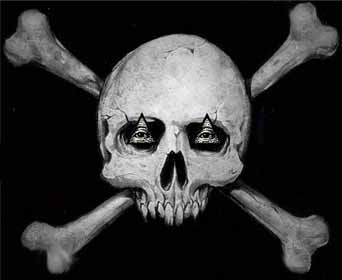
Skull and Bones
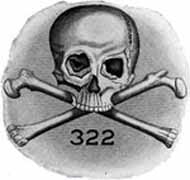
Skull and Bones is the most well known of the secret societies based at Yale University. It was founded in 1832 by William Huntington Russell and Alphonso Taft, two students who were not admitted into Phi Beta Kappa at Yale University, in New Haven, Connecticut.
The first Skull and Bones class, or "cohort", was in 1833. Skull and Bones is known by many names, including The Order of Death, The Order, The Eulogian Club, and Lodge 322. Initiates are most commonly known as Bonesmen, Knights of Eulogia, and Boodle Boys.
The females who have recently been permitted to become members would be known as Boneswomen, Ladies of Eulogia, and Boodle Girls.In public, its corporate name is the Russell Trust Association. In 1999 it had assets of $4,133,246.
Skull and Bones is the only secret society known to have a summer home and its own private island. This private island, one of the Thousand Islands lying in gray territorial area between the United States and Canada, was given to the Order by one of its early mysterious benefactor families who was associated with the secret society.
Differences between Skull and Bones and other fraternities
Skull and Bones is different from other semi-secretive fraternities and sororities on several points. First, its current membership rosters are a secret to the public, as well as its activities. Second, it is what is called a "senior society," in that only upcoming seniors are inducted into the secret society only for one year prior to graduation. Third, members have a history of committing crimes to further The Order. Whether these crimes are part of the initiation or simply as a mutual encouragement of peer pressure, is unknown. For instance, grave-robbing has been committed on several occasions.
The Skull and Bones Tomb was rumored to hold Geronimo's skull, which inspired Native American activist and Apache chief Ned Anderson to try to force a search and a DNA test. He would face many obstacles. As a Yale student in 1918, Prescott Bush, former Connecticut Senator, father of President George H. W. Bush and grandfather to President George W. Bush, had dug up the skull himself with two other students from its federal burial ground at Fort Sill, Oklahoma and presented it as a gift to the fraternity.
The FBI refused to enter the fray unless Anderson removed himself from the investigation and turned over any evidence he had, an offer Anderson refused. Anderson then claimed, with several pieces of evidence, that he had met with Jonathan Bush, the brother of then-Vice-President George H. W. Bush, who presented the infamous skull.
The skull was impossibly small, and is assumed to be of a child. Anderson then publicized the meeting, adding that the skull was not the one of Skull and Bones fame. A bonesman was quoted as saying about the incident, "We still call it Geronimo".
The New Haven Tomb is rumored in Yale's own magazine to hold the skulls of Pancho Villa and Che Guevara as well. Fourth, The Order inspires occasionally a fanatical loyalty. Members have been known to stab the Bones insignia into their flesh to keep it on them while showering or swimming.
Both John Kerry and George W. Bush are members of Skull and Bones. Bush refused to talk about their common membership in the Order of Death during his February 9, 2004 appearance on NBC's Meet The Press.
In another interview, when Kerry was in turn asked what could he reveal about Skull and Bones, Kerry said: "Well not much, because it's a secret... Sorry, I wish there was something I could manifest..." and then quickly changed the subject. Bush appointed 11 Skull and Bones members to his Administration in his first term.
The U.S. branch of a German secret society
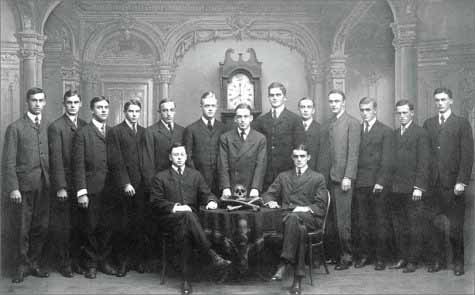
The Order has a private group portrait taken for every new cohort of fifteen. It is always posed in the same manner, showing human bones and a grandfather clock at 8 p.m.Skull and Bones is distinctly an outward-viewing secret society. It has a view outside Yale University because it is a senior society.
It also has an international outlook. Some people say that Skull and Bones is a U.S. chapter of an early 1800s German secret society. Those who have broken into the Bones "Tomb" (or those members who are disaffected from the Bones experience and wanted to report on them), describe many German-language pictures and themes on the walls and in daily use--from pictures of skulls, to swastikas, to the use of Hitler's silverware and table settings, obviously pilfered out of Germany after WWII.
Co-founder of the order, William Huntingdon Russell spent some time studying in Germany. It has been suggested that while he was there he was initiated into a secret society with a skull and bones for its emblem. Some even claim that he was initiated into a continuation of the Illuminati.Official material from Skull and Bones supports this theory.
First, an invitation to a thirteenth-anniversary describes a Jubilee Commemoration of the History of Our Establishment in New Haven.
Second, an historical address that has found its way from the tomb states The Eulogian Club: An Historical Discourse Pronounced before our Venerable Order on the Thirtieth Anniversary of the Foundation of our American Chapter in New Haven July 30th 1863 Thursday evening. By Timothy Dwight of 1849Š
Third, mentioned in the Kris Millegan book on Skull and Bones, according to information acquired from a break-in to the 'tomb' (the Skull and Bones meeting hall) in 1876, "Bones is a chapter of a corps in a German University....General Russell, its founder, was in Germany before his Senior Year and formed a warm friendship with a leading member of a German society. He brought back with him to college, authority to found a chapter here."
Fourth, a 1933 Bones document refers to the ³birth of our Yale chapter.² It is also suggested that when Bonesmen refer to the order as Lodge 322 they are acknowledging that they are but a chapter of a secret society.Another piece of information that implies Skull and Bones is a branch of another secret society is that the techniques used at Yale by Bones are far from unique.
The identitical pattern of techniques are seen in Brown University's Society of the Pacifica House. Exactly like Yale's Skull and Bones, Brown University's 'version' is a senior society full of tapped juniors, a cohort of strictly fifteen annually, and it as well employs high secrecy.
Indeed, this pattern of secretive and ritualistic recruitment is also witnessed at other institutions, such as the Sphinx senior society at Dartmouth.
Bonesman socialization: core families of "Knights" versus "Barbarians"
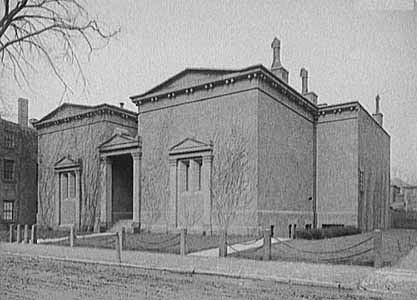
The Skull and Bones tomb
Starting in 1833, each year one of the responsibilities of the cohort of fifteen seniors is to select fifteen new junior members to replace them. This is called being "tapped" (selected) for the society. To be tapped for Skull and Bones is seen by many Yale students as the highest honor that can be attained, though some occasionally refuse.
For a year, Bones members meet at least weekly and conduct long self-analysis of each other and critique. This is aimed at creating a long term bond between them as they leave the university instead of during their stay at the university. Within the Bones 'tomb' are rooms which some believe to be used for Satanic worship or other occult practices. Kris Millegan writes that the room is uncannily arranged like a room arranged for an entrance into an higher level of the Bavarian Illuminati.
There are innumerable human skulls and bones in the 'tomb,' which of course is illegal under Connecticut law. Bones members are reported to be forced to reveal their innermost secrets and their "sexual biography" to one another. It has been suggested that this may be used for blackmailing.
In the tomb with each other for one year, members dine off Hitler's china set and silverware consuming expensive gourmet meals cooked for them by their own private chef. Members are given new code names. Plus, the members call themselves "Knights," and simultaneously call everyone else in the world at large "barbarians."
The Order encourages members to view the world outside of Skull and Bones in a desensitized and dissimulating fashion. Another dissociation is that clocks in the Bones 'tomb' run intentionally five minutes fast from the rest of the world, to give the members an ongoing sense that the Bonesmen's space is a totally separate world--and a world just a bit ahead of the curve of the rest of the "barbarians" outside.
Partially, "tapping" is a response to visible or anticipated excellence, thus it could be considered meritocratic. However, since a great many members of the membership in this secret society are drawn over and over from the same families as the "core" of the group, it is a typical nested secret society with "porch brethren" on the outside making a power network for those in the inner administrative levels of the secret society.
The top repetitive families in Skull and Bones are known because in 1985 a disgruntled Skull and Bones member leaked rosters to a private researcher, Antony C. Sutton. Many people believe that the membership of Skull and Bones had been totally secret.
However the membership for each year is held in the Yale University archives.The membership rosters cover the years 1833-1985, with some additional years.
This original leaked 1985 data was kept privately for over 15 years, as Sutton feared that the xeroxed pages could somehow identify the member who leaked it. The information was finally reformatted as an appendix in the book Fleshing out Skull and Bones by editor, researcher, and writer Kris Millegan, who published it in 2003.
The data shows that certain families have been well represented, and that these happen to be related to each other as well - such as the Cheney family, Taft family, Whitney family, Walker family, and Adams family. Other subordinate members are often related to these families.
Other core family names are common. However, not all initiates in these families are as interrelated as the above group. This second category of core families covers such names as Smith, Allen, Brown, Clark, White, Day, Johnson, Jones, Miller, Stewart, Thompson, Cheney, Taft, Williams.
For an example of the predilection of certain core families being embedded in Skull and Bones (or vice versa), here are the top 15 families in Skull and Bones with 10+ Members (over 1833-1985, with occasional later years available:
- Smith (15)
- Walker (15)
- Allen (13)
- Brown (13)
- Clark (12)
- White (12)
- Day (11)
- Johnson (11)
- Jones (11)
- Miller (11)
- Stewart (11)
- Thompson (11)
- Cheney (10)
- Taft (10)
- Williams (10)
On an initiate's first day in Bones they are assigned a name, which they will be known as for the rest of their life. Names that are regularly used are: Magog, which is assigned to the initiate with the most experience with the opposite sex; Gog, which is assigned to the least sexually experienced; Long Devil, for the tallest; Boaz, for varsity American football captains; and Little Devil for the shortest. Bonesmen have often assumed names of mythological and legendary figures.
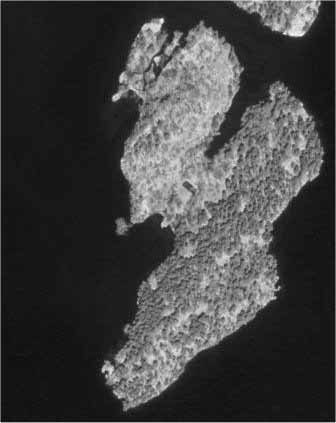
Aerial view of Deer Island, in the St. Lawrence River between Canada and the United States; the retreat's facilities today are reportedly dilapidatedDeer Island is a privately owned island retreat owned by Skull and Bones' Russell Trust Association. It is on the Saint Lawrence River two miles (3 km) north of Alexandria Bay. Among the island's facilities are two tennis courts, two houses, a bungalow, a boathouse, and an amphitheater. It serves as a getaway for the present members of Skull and Bones, and is often used to host reunions to which family members of Bonesmen are welcome. It can also be hired out for personal use, but membership of Skull and Bones as well as upkeep is required. The island is governed and maintained by the Deer Island Club, membership of which is only available for initiates of Skull and Bones. They say in their articles of association, the purpose of the club is:
- ...to promote the social intercourse of its members, and to provide for them facilities for recreation and social enjoyment; and to this end, to purchase, hold and convey any property, real or personal, which may be necessary or convenient therefor; to maintain a Club House for the use and benefit of its members; and to adopt by-laws and generally to exercise all the usual powers of corporations not prohibited by said statutes
Cultural References
In 2000, Universal Pictures released The Skulls starring Joshua Jackson and Paul Walker as rising seniors at Yale who were inducted into the secret society. After witnessing a cover-up of a murder, one character tries to defect from the group. The society is portrayed as having intergroup tensions, cover-ups, lavish lifestyles, and corrupt business deals. The film received very poor reviews.Fictional character Charles Montgomery Burns of The Simpsons was supposedly a member of the Skull and Bones before his graduation from Yale in 1914. In "The Canine Mutiny", an episode from the eighth Simpsons season, Burns identifies Laddie the collie as a potential Boneshound.




0 comments:
Post a Comment